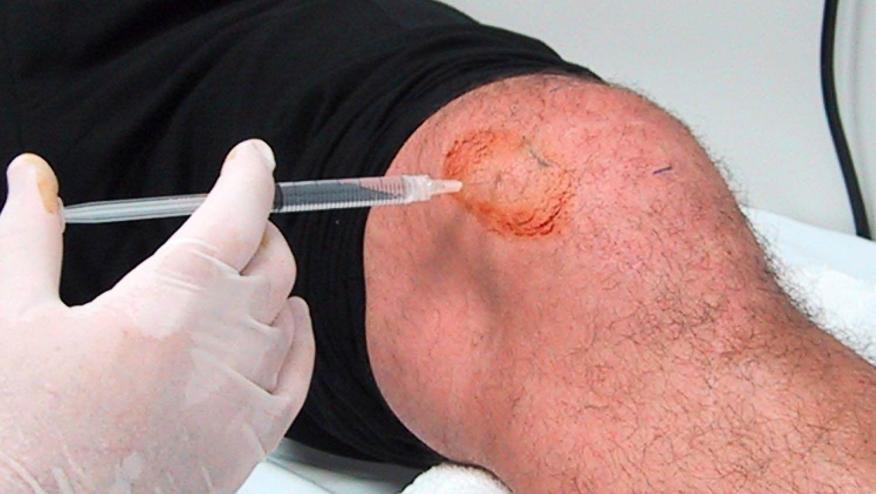Docs' Liking for Knee Injection Tied to Industry Payments Save

Physicians accepting payments from drug and device companies administered significantly more hyaluronic acid (HA) injections to Medicare beneficiaries for knee osteoarthritis, researchers found.
Those receiving more than $100 in cash or other forms of remuneration were more than three times as likely to give HA injections under Medicare Part B than those receiving no payments (OR 3.28, 95% CI 2.70-3.98), according to Nishant Uppal, MD, MBA, of Brigham and Women's Hospital, and Timothy S. Anderson, MD, MAS, of Beth Israel Deaconess Medical Center, both in Boston.
The number of injections given was also linked to industry payments. The researchers calculated a rate ratio of 2.15 (95% CI 1.92-2.41) for giving HA shots among physicians with "high procedural volume," defined as more than 250 large joint injections annually, among those paid more than $100 versus physicians receiving no industry monies.
JAMA Internal Medicine published the study as part of its "Less Is More" seriesopens in a new tab or window, highlighting treatments and procedures with questionable benefits for patients.
"Guidelines recommend against routine use of hyaluronic acidopens in a new tab or window, yet Medicare spending on hyaluronic acid exceeded $440 million in 2019," Uppal and Anderson observed, noting as well that meta-analysesopens in a new tab or window have not found that such injections help patients substantially.
The researchers explained that Medicare Part B reimburses HA injections as the average sales price plus 4.3%, which "along with industry payments may encourage low-value service use," they asserted.
To test the hypothesis, the pair pulled Medicare Part B data for 2019 to identify physicians giving more than 50 large joint injections per year, cross-referencing those data with records from the government's Open Payments systemopens in a new tab or window.
Among the 20,501 such physicians identified, 41.5% were recorded as administering HA injections. Industry payments could be in the form of actual cash, as compensation for participating in continuing medical education programs (CME, accredited or otherwise), or as free meals, travel, and entertainment. The latter category accounted for about 40% of the total average remuneration of $143 for those receiving any type of payment. (Among physicians accepting cash and CME compensation, the average in those categories was a whopping $13,518.)
Uppal and Anderson calculated that the probability of giving HA injections increased by 21.0 percentage points for physicians paid more than $100 and by 12.7 percentage points for those paid $1-$100.
"These results suggest industry payments are associated with increased use of an invasive, high-cost procedure widely considered to have little benefit, which is discouraged by orthopedics and rheumatology guidelines," the pair wrote.
Other findings included that primary care physicians were significantly (P<0.05) more likely to be doling out HA than orthopedic surgeons (rate ratio 1.12), pain specialists (RR 1.25), or rheumatologists (RR 2.04).
Additional factors predicting HA injection-giving included (all P<0.05):
- Female versus male physician: RR 1.29
- DO versus MD: RR 1.18
- Years in practice >10: RR 1.17-1.43 as stratified by decade, versus 10 or less
- Urban practice setting: RR 1.27-2.86 versus large town, small town, or rural
- Large joint injection volume >250 annually: RR 33.31
"Professional guidelines may be inadequate to reduce low-value care delivery," Uppal and Anderson concluded, "necessitating policy change through Medicare Part B reimbursement redesign and industry payment restrictions."
Limitations to the analysis included reliance on administrative data for both Medicare and industry payments. Also, the researchers did not analyze which companies had made payments (i.e., vendors of HA vs other types of products).
Source Reference: Uppal N, et al "Association between pharmaceutical industry marketing payments to physicians and intra-articular hyaluronic acid administration to Medicare beneficiaries" JAMA Intern Med 2023; DOI: 10.1001/jamainternmed.2022.7018.









If you are a health practitioner, you may Login/Register to comment.
Due to the nature of these comment forums, only health practitioners are allowed to comment at this time.